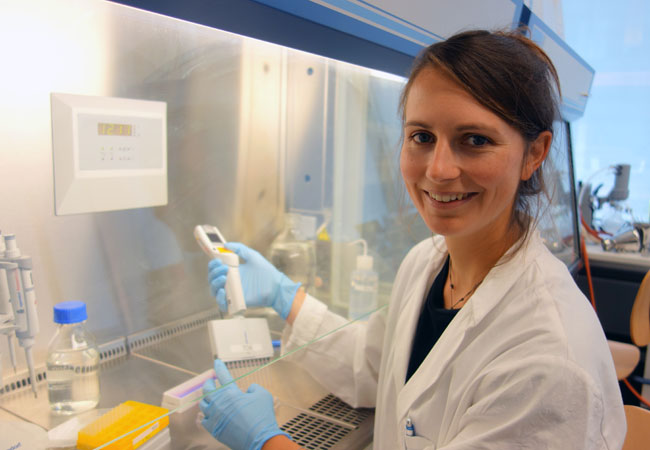Sep 18 2020
Bioplastics are allegedly marketed as an eco-friendly alternative to traditional, petroleum-based plastics. They might be bio-degradable, can be produced from renewable feedstock, or even both.
 Lisa Zimmermann from Goethe University Frankfurt testing chemical substances extracted from bioplastics in cultured cells. Image Credit: Institute for Social-Ecological Research (ISOE).
Lisa Zimmermann from Goethe University Frankfurt testing chemical substances extracted from bioplastics in cultured cells. Image Credit: Institute for Social-Ecological Research (ISOE).
But the question is whether these biomaterials are safer than traditional plastics with respect to the chemicals they contain. This question has been addressed in a new study recently published in the Environment International journal.
A team of researchers from the Goethe University Frankfurt and PlastX had examined everyday products produced from bio-based and/or biodegradable materials and now they have reported that these alternatives contain chemicals that are similar to those found in traditional plastics.
There has been a tremendous public pressure when it comes to plastic products. The manufacturing from petroleum is believed to be unsustainable, the global plastic waste issue is mostly unresolved, and because they may contain harmful substances like bisphenol A, everyday plastics frequently make the headlines.
As a result, new materials have penetrated the market promising a better environmental footprint. These materials include bioplastics that can be bio-based (e.g. made from renewable feedstock such as bio-polyethylene) and biodegradable (they decompose under natural conditions like polylactic acid).
It is possible to make other alternative materials from plant-based materials, like cellulose. However, it is not known whether these biomaterials are safer than traditional plastics with respect to the chemicals they contain.
Three out of Four Products Contain Chemicals that are Toxic in vitro
Under the guidance of the Institute for Social-Ecological Research (ISOE), the PlastX research team has dealt with this question in a new study in association with the Norwegian University of Science and Technology and the Goethe University of Frankfurt.
To date, it is the most comprehensive study that investigates the toxicity of bioplastics, chemical composition, and plant-based materials and compares them with traditional plastics.
In order to test for potential adverse effects of plastic chemicals, we extracted them from the everyday products and analysed them to in vitro bioassays. Our results demonstrate that bio-based and biodegradable materials are no safer than conventional ones.
Lisa Zimmermann, Study First Author, Geothe University Frankfurt
Zimmermann continued, “Three-quarters of the products contained harmful chemicals. This means that the products contain chemicals that have toxic effects in cells or act like hormones. The same is true for conventional plastics. Again, we found that three out of four products contained harmful chemicals.”
Biomaterials Contain up to 20.000 Chemicals
The 43 biodegradable and bio-based products that were investigated included, for example, wine corks, drinking bottles, chocolate packaging, and disposable tableware. Chemical analysis showed that 80% of the products contained over a thousand, with a few products containing up to 20,000 chemicals.
“Cellulose- and starch-based products contained most chemicals. They also triggered a stronger in vitro toxicity than others,” explained the biologist Zimmermann.
From Raw Material to End Product: Overall Toxicity Increases
Conversely, the study showed that the end products that were investigated included a higher toxicity and a broader range of chemicals when compared to the raw materials from which they were produced.
This indicates that new substances are produced or added at the time of converting the raw material into the end product. However, each biodegradable and bio-based product also had an “individual” chemical composition.
That makes it almost impossible to make general statements about the safety of specific materials. While a bio-polyethylene bag intended for food contact might contain toxic chemicals, a wine cork made of the same material might not and vice versa.
Martin Wagner, Study Co-Author, University of Trondheim
Chemical Safety of Plastics Should Move onto the Political Agenda
The research shows: “For consumers it is not apparent whether they come in contact with harmful plastics, regardless of whether they are conventional or bio,” stated the PlastX project manager Carolin Völker.
Hence, Völker demands that the safety of chemicals utilized in plastics and alternative materials is ensured and already taken into account when developing new materials.
Especially since we are seeing a strong trend towards biomaterials, the aspect of chemicals safety needs to be put on the political agenda.
Carolin Völker, PlastX Project Manager, Institute for Social-Ecological Research
Until now, the exact impacts of plastic chemicals on the environment and humans are still unknown, and hence more studies are required to assess the risk of plastics and its alternatives.
While in vitro studies offer first evidence, they are evidently not enough to determine health and environmental impacts more thoroughly.
“In order to develop better alternatives to conventional plastics, ecological and societal aspects must be considered in addition to their chemical safety. These aspects include greenhouse gas emissions, competition with food production and recyclability”. Since here too, just like with bioplastics much remains to be desired, concluded Völker.
Journal Reference:
Zimmermann, L., et al. (2020) Are bioplastics and plant-based materials safer than conventional plastics? In vitro toxicity and chemical composition. Environment International. doi.org/10.1016/j.envint.2020.106066.